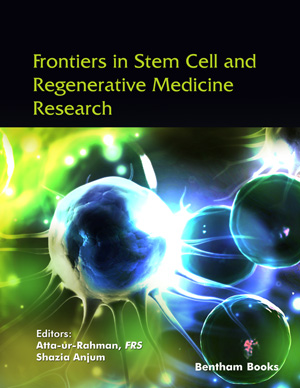Abstract
There has been a lot of interest in stem cell therapy as a means of curing disease in recent years. Despite extensive usage of stem cell therapy in the treatment of a wide range of medical diseases, it has been hypothesized that it plays a key part in the progression of cancer. Breast cancer is still the most frequent malignancy in women globally. However, the latest treatments, such as stem cell targeted therapy, are considered to be more effective in preventing recurrence, metastasis, and chemoresistance of breast cancer than older methods like chemotherapy and radiation. This review discusses the characteristics of stem cells and how stem cells may be used to treat breast cancer.
Graphical Abstract
[http://dx.doi.org/10.1002/ijc.1440] [PMID: 11668491]
[http://dx.doi.org/10.4161/cbt.6.3.3994] [PMID: 17387266]
[http://dx.doi.org/10.1172/JCI45014] [PMID: 21633166]
[http://dx.doi.org/10.1002/mc.23277] [PMID: 33428807]
[http://dx.doi.org/10.1016/S1470-2045(02)00820-3] [PMID: 12147437]
[http://dx.doi.org/10.1038/35102154] [PMID: 11689953]
[http://dx.doi.org/10.1016/j.biopha.2022.112616]
[http://dx.doi.org/10.1093/nar/gkq929] [PMID: 20952405]
[http://dx.doi.org/10.1002/gcc.20366] [PMID: 16897746]
[http://dx.doi.org/10.1007/s12282-017-0812-x] [PMID: 29086897]
[http://dx.doi.org/10.1177/1758834014530023] [PMID: 25057302]
[http://dx.doi.org/10.1038/nature14665] [PMID: 26266985]
[http://dx.doi.org/10.1038/nature15260] [PMID: 26416748]
[http://dx.doi.org/10.1158/2326-6066.CIR-18-0487] [PMID: 30510057]
[PMID: 28870893]
[http://dx.doi.org/10.1038/sj.onc.1206394] [PMID: 12761490]
(b) Finn RS, Aleshin A, Slamon DJ. Targeting the cyclin-dependent kinases (CDK) 4/6 in estrogen receptor-positive breast cancers. Breast Cancer Res 2016; 18: 17.
[http://dx.doi.org/10.1080/13543776.2022.2078193] [PMID: 35583393]
[http://dx.doi.org/10.1016/j.cell.2008.01.020] [PMID: 18267068]
[http://dx.doi.org/10.1089/omi.2017.0020] [PMID: 28388298]
[http://dx.doi.org/10.1016/j.stem.2018.06.002] [PMID: 30082067]
[http://dx.doi.org/10.1016/j.stem.2018.01.016] [PMID: 29456158]
[http://dx.doi.org/10.1038/nm.2000] [PMID: 19648928]
[PMID: 30094089]
[http://dx.doi.org/10.20517/cdr.2020.106] [PMID: 35582030]
[http://dx.doi.org/10.1002/jcp.28271] [PMID: 30741412]
[http://dx.doi.org/10.3389/fimmu.2019.01510] [PMID: 31338094]
[http://dx.doi.org/10.1007/s12015-007-0016-4] [PMID: 17873342]
[http://dx.doi.org/10.1038/nbt0109-44] [PMID: 19131997]
[http://dx.doi.org/10.1016/j.stem.2010.11.012] [PMID: 21112562]
[http://dx.doi.org/10.1016/j.bbrc.2008.10.052] [PMID: 18948085]
[http://dx.doi.org/10.1038/35002607] [PMID: 10706289]
[http://dx.doi.org/10.1126/science.1171837] [PMID: 19556499]
[http://dx.doi.org/10.1002/jcb.21460] [PMID: 17647265]
[http://dx.doi.org/10.1016/j.cell.2006.07.024] [PMID: 16904174]
[http://dx.doi.org/10.1016/j.stem.2007.05.014] [PMID: 18371336]
[http://dx.doi.org/10.1038/nature05934] [PMID: 17554338]
[http://dx.doi.org/10.1016/S0092-8674(00)81769-9] [PMID: 9814708]
[http://dx.doi.org/10.1016/j.bbagrm.2013.10.001] [PMID: 24145198]
[http://dx.doi.org/10.1002/glia.20800] [PMID: 18985733]
[http://dx.doi.org/10.1002/stem.2059] [PMID: 26013162]
[http://dx.doi.org/10.1038/modpathol.3800760] [PMID: 17334350]
[http://dx.doi.org/10.1093/neuonc/nor113] [PMID: 21940738]
[http://dx.doi.org/10.18632/oncotarget.16750] [PMID: 28422735]
[http://dx.doi.org/10.1016/j.bbrc.2018.07.145] [PMID: 30078675]
[http://dx.doi.org/10.1158/0008-5472.CAN-05-0626] [PMID: 15994920]
[http://dx.doi.org/10.1371/journal.pone.0002637] [PMID: 18612434]
[http://dx.doi.org/10.1634/stemcells.2008-0493] [PMID: 18948646]
[http://dx.doi.org/10.1038/onc.2011.405] [PMID: 21927024]
[http://dx.doi.org/10.1038/nature13305] [PMID: 24909994]
[http://dx.doi.org/10.1016/S0092-8674(03)00392-1] [PMID: 12787505]
[http://dx.doi.org/10.1007/s12282-012-0357-y] [PMID: 22528804]
[http://dx.doi.org/10.1007/s12032-011-9860-9] [PMID: 21336986]
[http://dx.doi.org/10.1016/j.oraloncology.2010.12.001] [PMID: 21292542]
[http://dx.doi.org/10.1158/0008-5472.CAN-10-2638] [PMID: 21159654]
[http://dx.doi.org/10.4161/cbt.9.4.10666] [PMID: 20026903]
[http://dx.doi.org/10.1002/stem.1182] [PMID: 22851508]
[http://dx.doi.org/10.1371/journal.pone.0072435] [PMID: 24023739]
[http://dx.doi.org/10.1002/stem.29] [PMID: 19415763]
[http://dx.doi.org/10.1016/j.canlet.2013.07.009] [PMID: 23872274]
[http://dx.doi.org/10.1016/j.yexcr.2008.10.004] [PMID: 18977346]
[http://dx.doi.org/10.1111/j.1600-0463.2007.apm_643.x] [PMID: 17614846]
[http://dx.doi.org/10.1158/1078-0432.CCR-04-0619] [PMID: 15447986]
[PMID: 24183943]
[http://dx.doi.org/10.1007/s00535-014-0956-9] [PMID: 24728665]
[http://dx.doi.org/10.1634/theoncologist.2010-S4-05] [PMID: 21115576]
[http://dx.doi.org/10.1016/j.jhep.2006.05.013] [PMID: 16879891]
[http://dx.doi.org/10.1038/nature12347]
[http://dx.doi.org/10.1038/nature10599] [PMID: 22080947]
[http://dx.doi.org/10.1038/nature16969] [PMID: 26934227]
[http://dx.doi.org/10.1002/ijc.29227] [PMID: 25242378]
[http://dx.doi.org/10.1084/jem.20071082] [PMID: 17984306]
[http://dx.doi.org/10.1111/j.1365-2559.2009.03475.x] [PMID: 20459529]
[http://dx.doi.org/10.1158/1078-0432.CCR-09-2823] [PMID: 20530696]
[http://dx.doi.org/10.1007/s12282-021-01310-4] [PMID: 34725795]
[http://dx.doi.org/10.1158/0008-5472.CAN-09-1681] [PMID: 20068161]
[http://dx.doi.org/10.1172/JCI88486] [PMID: 27869648]
[http://dx.doi.org/10.1016/j.taap.2022.115887]
[http://dx.doi.org/10.1007/s12672-011-0066-6] [PMID: 21761332]
[http://dx.doi.org/10.1634/stemcells.2007-0691] [PMID: 18292212]
[http://dx.doi.org/10.3389/fonc.2022.856974] [PMID: 35392236]
[PMID: 20799146]
[http://dx.doi.org/10.1172/JCI41004] [PMID: 20051635]
[http://dx.doi.org/10.1038/bonekey.2013.105] [PMID: 24422098]
[http://dx.doi.org/10.1016/j.canlet.2017.02.023] [PMID: 28254410]
[http://dx.doi.org/10.1172/JCI57099] [PMID: 21965337]
[http://dx.doi.org/10.1093/intimm/dxq030] [PMID: 20410258]
[http://dx.doi.org/10.1186/bcr2479] [PMID: 20158881];
(b) Phillips TM, McBride WH, Pajonk F. The response of CD24(-/low)/CD44+ breast cancer-initiating cells to radiation. J Natl Cancer Inst 2006; 98(24): 1777-85.
[http://dx.doi.org/10.1093/jnci/djj495] [PMID: 17179479]
[http://dx.doi.org/10.1038/nature07733] [PMID: 19194462]
[http://dx.doi.org/10.1371/journal.pone.0024080] [PMID: 21935375]
[http://dx.doi.org/10.3322/caac.21442] [PMID: 29313949]
[http://dx.doi.org/10.1186/bcr2108] [PMID: 18559090]
[http://dx.doi.org/10.2174/1574888X16666210810100858]
[http://dx.doi.org/10.1007/s00520-020-05858-3] [PMID: 33170403]
[http://dx.doi.org/10.1038/onc.2008.207] [PMID: 18591932]
[http://dx.doi.org/10.1016/j.cmet.2018.06.006] [PMID: 29972798]
[http://dx.doi.org/10.1016/j.ctrv.2017.11.003] [PMID: 29202431]
[http://dx.doi.org/10.3390/cancers11091240] [PMID: 31450577]
[http://dx.doi.org/10.3390/molecules23092193] [PMID: 30200262]
[PMID: 21687939]
[http://dx.doi.org/10.1186/s13058-015-0662-4] [PMID: 26757880]
[http://dx.doi.org/10.1073/pnas.1314239110] [PMID: 24277854]
[http://dx.doi.org/10.1002/brb3.2740] [PMID: 35971625]
[http://dx.doi.org/10.3389/fonc.2019.01311] [PMID: 31867270]
[http://dx.doi.org/10.1158/0008-5472.SABCS12-OT2-3-05]
[http://dx.doi.org/10.1186/s12967-020-02260-9] [PMID: 32050983]
[http://dx.doi.org/10.1016/j.biomaterials.2015.08.007] [PMID: 26283155]











